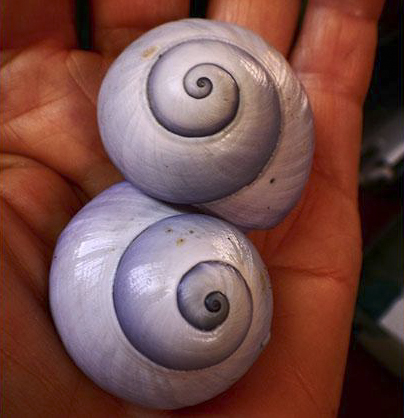Published in the Ocean Watch column, Honolulu Star-Advertiser © Susan Scott
November 9, 2015
AIRCRAFT BEACH, EURIMBA NATIONAL PARK, Australia » For me, beach walking is often as rewarding as snorkeling. Sure, marine animals lying on beaches are dead or dying, but that means I can pick them up or turn them over and admire to my heart’s content. The long-dead animals I found stranded on this 2-mile-long sand beach, suitable for small plane landings, are the largest violet snail shells I’ve ever seen, nearly 2 inches long and an inch high. The exquisite shells, lavender above and purple below, lay 50 or so feet above the high tide line, suggesting that storm winds drove the snails toward shore and high waves spit them out. Most violet snails have better luck. Healthy ones float offshore, upside down, on self-made bubble rafts. Some believe that the snail agitates water with its foot to make bubbles. Another theory is that the snail blows bubbles from air it has taken into its shell. In either case, the creature secretes mucus from its foot to coat its bubbles, creating a rubbery raft.
 Violet snails shells are left behind by animals
Violet snails shells are left behind by animals
that survive by eating Portuguese men-of-war.
©2015 Susan Scott
It’s a precarious existence. To lose the raft is to sink to the bottom and drown. These air-breathing snails can’t swim.
Nor can they steer. Throughout the world’s tropical oceans, violet snails and other members of their drifting community, including Portuguese men-of-war (called blue bottles here in Australia), are at the mercy of winds and currents. That’s why during strong onshore winds, we find both species stranded on beaches.
Unlike us, violet snails don’t get a sting when they bump into blue bottle tentacles. They get a meal. Portuguese men-of-war are violet snails’ main food.
When an animal can’t control its course, it’s tough for the sexes to get together. As a result, when a male violet snail senses a female in the area — they can’t see each other because violet snails have no eyes — he ejects sperm in her general direction. When the sperm hit their target, the female lays eggs and carries them with her beneath her bubble raft.
Eggs hatch into a drifting underwater form. When they mature, the tiny snails build their own bubble rafts and continue the nomadic existence.
I’ve often found violet snail shells on Hawaii’s windward beaches, and could fit about 10 in my palm. Here two barely fit. The snails might be different species, or the big ones might have grown large due to these nutrient-rich waters. On the same beach, I also found the biggest Portuguese man-of-war I’ve ever seen. Whatever their size, violet shells on any beach give me a fine marine animal fix. And I don’t even have to get wet.